【調變解調】SSB 單邊帶調幅
說明
學習數位訊號處理演演算法時整理的學習筆記。同系列文章目錄可見 《DSP 學習之路》目錄,程式碼已上傳到 Github - ModulationAndDemodulation。本篇介紹 SSB 單邊帶調幅訊號的調變與解調,內附全套 MATLAB 程式碼。
- 說明
- 1. SSB 調變演演算法
- 2. SSB 解調演演算法
- 3. SSB 模擬(MATLAB Communications Toolbox)
- 參考資料
- 附錄程式碼
- 附.1 檔案 lpf_filter.m
- 附.2 檔案 hpf_filter.m
- 附.3 檔案 mod_lsb_method1.m
- 附.4 檔案 mod_lsb_method2.m
- 附.5 檔案 mod_usb_method1.m
- 附.6 檔案 mod_usb_method2.m
- 附.7 檔案 main_modSSB_example1.m
- 附.8 檔案 main_modSSB_example2.m
- 附.9 檔案 demod_ssb_method1.m
- 附.10 檔案 demod_ssb_method2.m
- 附.11 檔案 demod_ssb_method3.m
- 附.12 檔案 demod_ssb_method4.m
- 附.13 檔案 main_demodSSB_example1.m
- 附.14 檔案 main_demodSSB_example2.m
- 附.15 檔案 main_demodSSB_example3.m
- 附.16 檔案 main_demodSSB_example4.m
- 附.17 檔案 main_CommSSB_example.m
1. SSB 調變演演算法
1.1 演演算法描述
DSB 訊號兩個邊帶中的任意一個都包含了調變訊號頻譜 \(M(\omega)\) 的所有資訊,因此僅傳輸其中一個邊帶即可,這樣既節省傳送功率,還節省 \(1/2\) 的傳輸頻寬,這種方式稱為單邊帶調變(SSB, Single Side Band)。SSB 訊號的頻寬等於基頻訊號(調變訊號)頻寬 \(f_H\),即 \(B_{SSB}=f_{H}\),根據傳輸的邊帶位置,SSB 訊號可分為上邊帶訊號(USB, Upper Side Band)和下邊帶訊號(LSB, Lower Side Band)。SSB 訊號是將雙邊帶訊號中的一個邊帶濾掉而形成的,根據濾除方法的不同,產生SSB 訊號的方法有:濾波法和相移法。
1.2 濾波法及 SSB 訊號的頻域表示
產生 SSB 訊號最直觀的方法是,先產生一個雙邊帶 DSB 訊號,然後讓其通過一個邊帶濾波器(理想高通濾波器或理想低通濾波器),濾除不必要的邊帶,即可得到單邊帶 SSB 訊號,這種方法被稱為濾波法。其原理框圖如下:
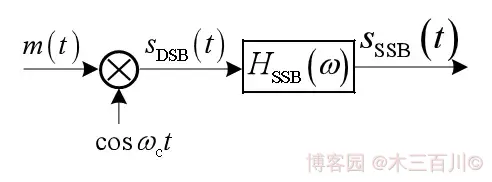
其中 \(H_{SSB}(\omega)\) 為單邊帶濾波器的傳輸函數,當它為理想高通濾波器時,可以濾除 DSB 訊號的下邊帶,獲得上邊帶 USB 訊號:
當 \(H_{SSB}(\omega)\) 為理想低通濾波器時,可以濾除 DSB 訊號的上邊帶,獲得下邊帶 LSB 訊號:
因此,SSB 訊號的頻譜表示式為:
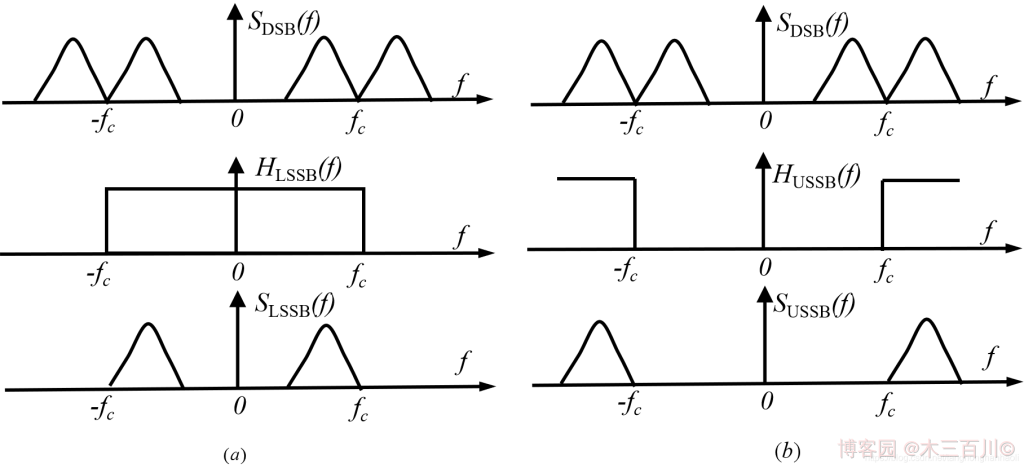
濾波法的技術難點是邊帶濾波器的製作,因為實際濾波器都不具有理想濾波器這麼陡峭的截止特性,而是有一定的過渡帶。例如,若經過濾波後的語音訊號的最低頻率為 \(300Hz\),則上、下邊帶之間的頻率間隔為 \(600Hz\),即允許過渡帶為 \(600Hz\)。實現濾波器的難易程度與過渡帶相對載頻的歸一化值有關,該值越小,邊帶濾波器就越難實現。因此在 \(600Hz\) 過渡帶和不太高的載頻情況下,濾波器不難實現;但當載頻較高時,採用一級調變直接濾波的方法已不可能實現單邊帶調變。這時可以採用多級(一般採用兩級)DSB 調變及邊帶濾波的方法,即先在較低的載頻上進行 DSB 調變,目的是增大過渡帶的歸一化值,以利於濾波器的製作,經單邊帶濾波後再在要求的載頻上進行第二次調變及濾波(常稱為變頻)。但當調變訊號中含有直流及低頻分量時濾波法就不適用了。
1.3 相移法及 SSB 訊號的時域表示
SSB 訊號時域表示式的推導比較困難,需藉助希爾伯特變換來表述,先以單頻調變為例,然後推廣到一般情況。設單頻調變訊號為:
載波為:
則 DSB 訊號的時域表示式為:
保留上邊帶,則有:
保留下邊帶,則有:
把上、下邊帶公式合併起來寫,可以寫成:
式中:「\(-\)」 表示上邊帶 USB 訊號,「\(+\)」 表示下邊帶 LSB 訊號。在式 \((8)\) 中 \(A_msin(\omega_mt)\) 可以看成是 \(A_mcos(\omega_mt)\) 相移 \(\pi/2\) 的結果,而幅度大小保持不變,我們把這一過程稱為希爾伯特變換,記為 「\(\land\)」,則有:
據此,式 \((8)\) 可以改寫為:
這個關係雖然是在單頻調變下得到的,但是因為任意一個基頻波形總可以表示成許多正弦訊號之和,所以不失一般性,可得到調變訊號為任意訊號時 SSB 訊號的時域表示式,式中 \(\hat{m}(t)\) 為 \(m(t)\) 的希爾伯特變換:
若 \(M(\omega)\) 為 \(m(t)\) 的傅立葉變換,則 \(\hat{m}(t)\) 的傅立葉變換為:
式中 \(sgn(\omega)\) 為符號函數:
式 \((10)\) 表明:除直流外,模值 \(H_h(\omega)=1\),希爾伯特濾波器 \(H_h(\omega)\) 將 \(m(t)\) 中的正頻率偏移 \(-\pi/2\),負頻率偏移 \(\pi/2\) 後就可以得到 \(\hat{m}(t)\)。根據 SSB 訊號時域表示式式 \((9)\) 可以設計出相移法 SSB 調變器的一般模型:
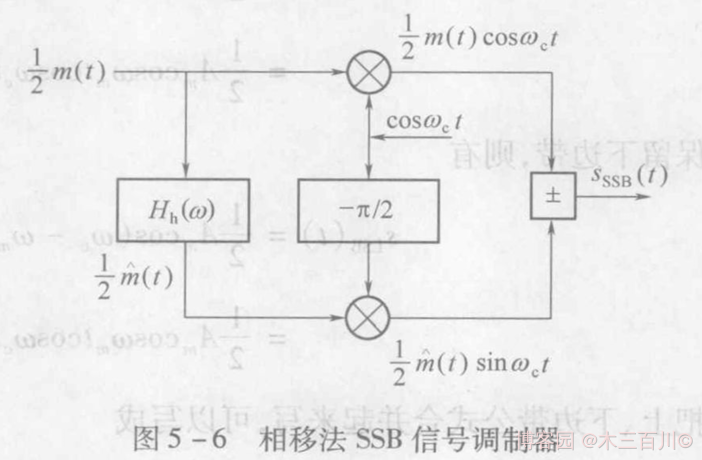
相移法的思路是利用相移網路 \(H_h(\omega)\) 對載波和調變訊號進行適當的相移,以便在合成過程中將其中的一個邊帶抵消而獲得 SSB 訊號,這種方法不需要濾波器具有陡峭的截止特性,不論載頻有多高,均可一次實現 SSB 調變。相移法的技術難點是 \(H_h(\omega)\) 的製作,它必須對調變訊號 \(m(t)\) 的所有頻率成分均精確相移 \(\pi/2\),達到這一點比較困難,可以採用維弗法(Weaver),感興趣的可查閱相關資料。
1.4 濾波法 SSB 訊號調變範例
調變訊號 \(m(t)\) 可以是確知訊號,也可以是隨機訊號。當 \(m(t)\) 是確知訊號時,不妨假設 \(m(t)\) 的時域表示式如下:
各調變引數取值:\(f_m=2500Hz\),\(f_c=20000Hz\)。訊號取樣率 \(f_s=8{f_c}\),模擬總時長為 \(2s\)。LSB 調變效果如下圖所示(為了美觀,時域只顯示前 500 個點),調變訊號 \(m(t)\) 雙邊幅度譜有四根離散譜線(\({\pm}2500Hz\)、\({\pm}1250Hz\)),DSB 訊號有八根離散譜線(\(\pm17500Hz\)、\(\pm18750Hz\)、\(\pm21250Hz\)、\(\pm22500Hz\)),LSB 訊號有四根離散譜線(\(\pm17500Hz\)、\(\pm18750Hz\))。
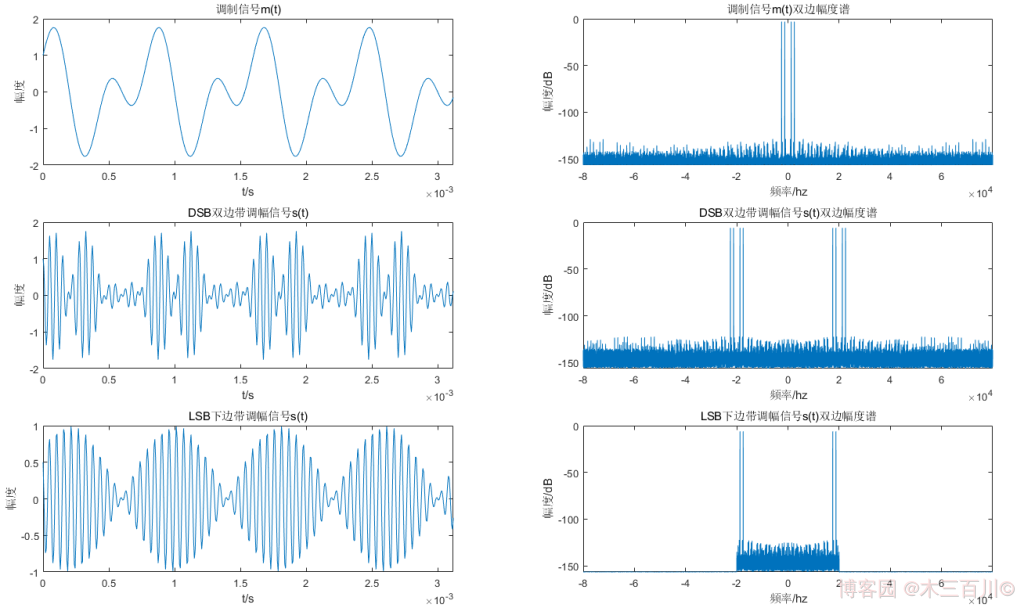
USB 調變效果如下圖所示(為了美觀,時域只顯示前 500 個點),調變訊號 \(m(t)\) 雙邊幅度譜有四根離散譜線(\({\pm}2500Hz\)、\({\pm}1250Hz\)),DSB 訊號有八根離散譜線(\(\pm17500Hz\)、\(\pm18750Hz\)、\(\pm21250Hz\)、\(\pm22500Hz\)),USB 訊號有四根離散譜線(\(\pm21250Hz\)、\(\pm22500Hz\))。

程式碼詳見 mod_lsb_method1.m、mod_usb_method1.m、main_modSSB_example1.m。
1.5 相移法 SSB 訊號調變範例
使用 1.4 節中相同的調變訊號,LSB 調變效果如下圖所示(為了美觀,時域只顯示前 500 個點),調變訊號 \(m(t)\) 雙邊幅度譜有四根離散譜線(\({\pm}2500Hz\)、\({\pm}1250Hz\)),\(m(t)\) 的希爾伯特變換 \(\hat{m}(t)\) 有四根離散譜線(\({\pm}2500Hz\)、\({\pm}1250Hz\)),LSB 訊號有四根離散譜線(\(\pm17500Hz\)、\(\pm18750Hz\))。

USB 調變效果如下圖所示(為了美觀,時域只顯示前 500 個點),調變訊號 \(m(t)\) 雙邊幅度譜有四根離散譜線(\({\pm}2500Hz\)、\({\pm}1250Hz\)),\(m(t)\) 的希爾伯特變換 \(\hat{m}(t)\) 有四根離散譜線(\({\pm}2500Hz\)、\({\pm}1250Hz\)),USB 訊號有四根離散譜線(\(\pm21250Hz\)、\(\pm22500Hz\))。
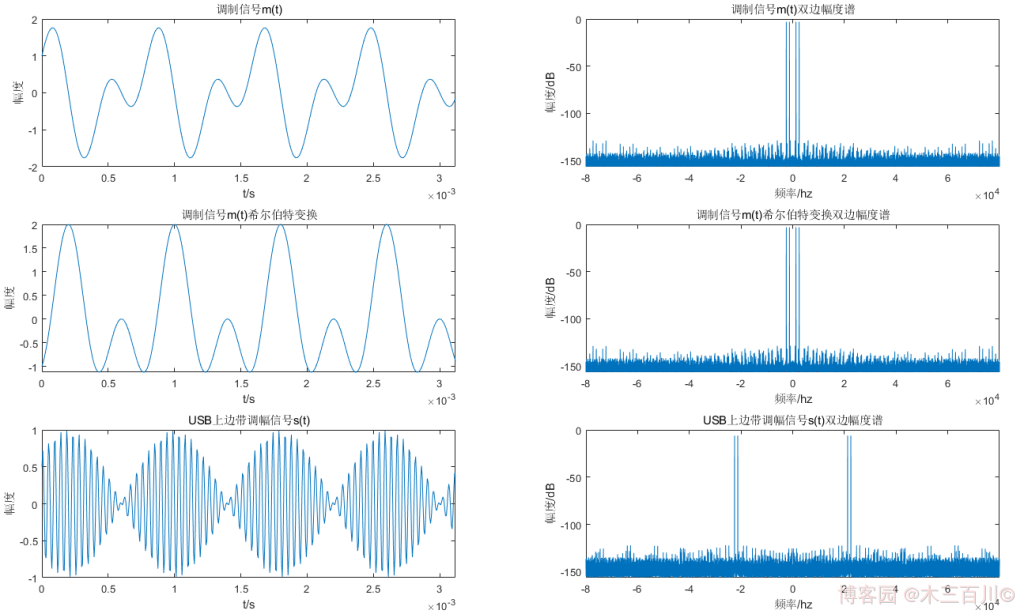
程式碼詳見 mod_lsb_method2.m、mod_usb_method2.m、main_modSSB_example2.m。
2. SSB 解調演演算法
解調是調變的逆過程,其作用是從接收的已調訊號中恢復原基頻訊號(即調變訊號)。SSB 訊號的包絡不再與調變訊號 \(m(t)\) 的變化規律一致,因而不能採用簡單的包絡檢波來恢復調變訊號,通常採用相干解調的方法來進行解調。另一種方法是,插入很強的載波,使其成為或近似為 AM 訊號,則可利用包絡檢波器恢復調變訊號,這種方法被稱為插入載波包絡檢波法,為了保證檢波質量,插入的載波振幅應遠大於訊號的振幅,同時也要求插入的載波與調變載波同頻同相。下面介紹四種解調方法並對 1.5 節中的 SSB 訊號進行解調。
2.1 插入載波包絡檢波法
插入幅值為 \(A_0\) 的載波,得到一個近似的 AM 訊號,使用 AM 解調器進行解調即可,步驟如下:
- 第一步:加上載波 \({A_0}cos{\omega_ct}\),其中 \(A_0 \geq {\lvert}{s_{SSB}(t)}{\rvert}_{max}\),獲得 AM 訊號。
- 第二步:使用 AM 解調器進行解調。
對 1.5 節中的 LSB 訊號,設定訊雜比 \(SNR=50dB\),解調效果如下,解調後幅度放大係數 \(k=\overline{{\lvert}m(t){\rvert}}/\overline{{\lvert}\hat{m}(t){\rvert}}\approx2.09\),使用這個係數放大解調訊號幅值,然後計算誤差,有:\(\sqrt{\sum{{\lvert}m(t_i)-k\hat{m}(t_i){\rvert}^2}}/\sqrt{\sum{{\lvert}m(t_i){\rvert}^2}}\approx0.2282\)。
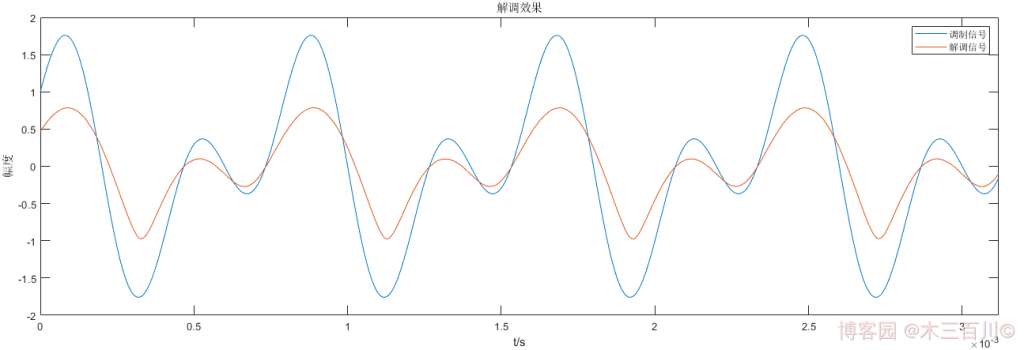
對 1.5 節中的 USB 訊號,設定訊雜比 \(SNR=50dB\),解調效果如下,解調後幅度放大係數 \(k=\overline{{\lvert}m(t){\rvert}}/\overline{{\lvert}\hat{m}(t){\rvert}}\approx2.09\),使用這個係數放大解調訊號幅值,然後計算誤差,有:\(\sqrt{\sum{{\lvert}m(t_i)-k\hat{m}(t_i){\rvert}^2}}/\sqrt{\sum{{\lvert}m(t_i){\rvert}^2}}\approx0.2282\),與 LSB 相同。

程式碼詳見 demod_ssb_method1.m 和 main_demodSSB_example1.m。AM 解調器詳見本人同系列部落格 【調變解調】AM 調幅。更改插入載波的初始相位為 \({\phi_0}=\pi/4,\pi/2\),或者更改插入載波的中心頻率為 \(0.8f_c,1.2f_c\) 後,解調效果變差,說明這種方法對插入載波同頻同相的要求較高。
2.2 相干解調(同步檢測)
將 SSB 訊號與同頻同相的相干載波相乘,得到:
然後通過一個低通濾波器即可獲得解調結果,步驟如下:
- 第一步:乘以相干載波(即乘以 \(4cos({\omega_ct}+{\phi_0})\),前面的 4 被用來做幅度補償。
- 第二步:低通濾波器濾除高頻載波,濾除 \(2{\omega}_c\)。
對 1.5 節中的 LSB 訊號,設定訊雜比 \(SNR=50dB\),解調效果如下,計算誤差,有:\(\sqrt{\sum{{\lvert}m(t_i)-\hat{m}(t_i){\rvert}^2}}/\sqrt{\sum{{\lvert}m(t_i){\rvert}^2}}\approx0.0022\)。
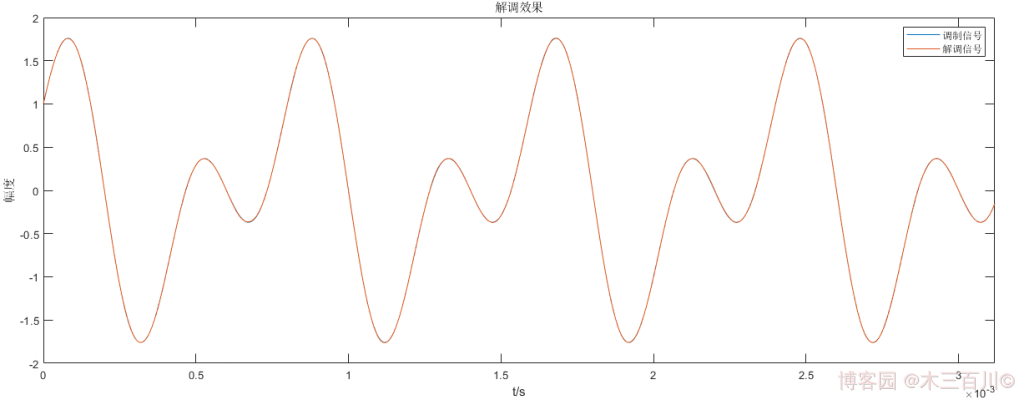
對 1.5 節中的 USB 訊號,設定訊雜比 \(SNR=50dB\),解調效果如下,計算誤差,有:\(\sqrt{\sum{{\lvert}m(t_i)-\hat{m}(t_i){\rvert}^2}}/\sqrt{\sum{{\lvert}m(t_i){\rvert}^2}}\approx0.0022\),與 LSB 相同。
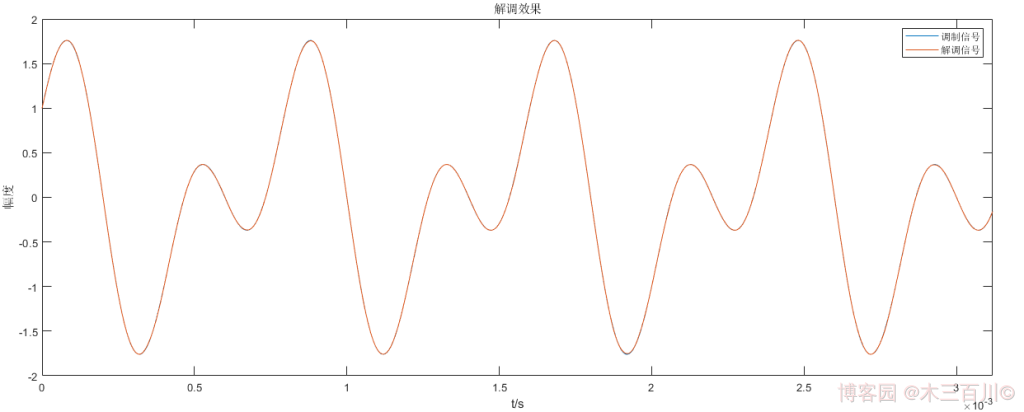
程式碼詳見 demod_ssb_method2.m 和 main_demodSSB_example2.m。更改相干載波的初始相位為 \({\phi_0}=\pi/4,\pi/2\),或者更改相干載波的中心頻率為 \(0.8f_c,1.2f_c\) 後,解調效果變差,說明這種方法對相干載波同頻同相的要求也較高。
2.3 數位正交解調
SSB 數位正交解調一般有以下兩個步驟,它與相干解調(同步檢測)法是等效的:
- 第一步:乘以正交相干載波得到 \({s_I}(t)\) 與 \({s_Q}(t)\),即 \({s_I}(t)=4s(t)cos({\omega_ct}+{\phi_0})\),\({s_Q}(t)=-4s(t)sin({\omega_ct}+{\phi_0})\),前面的 4 被用來做幅度補償。
- 第二步:低通濾波器濾除 \({s_I}(t)\) 與 \({s_Q}(t)\) 中的高頻分量,所得的 \(s_I(t)\) 即為解調結果。
對 1.5 節中的 LSB 訊號,設定訊雜比 \(SNR=50dB\),解調效果如下,計算誤差,有:\(\sqrt{\sum{{\lvert}m(t_i)-\hat{m}(t_i){\rvert}^2}}/\sqrt{\sum{{\lvert}m(t_i){\rvert}^2}}\approx0.0022\)。
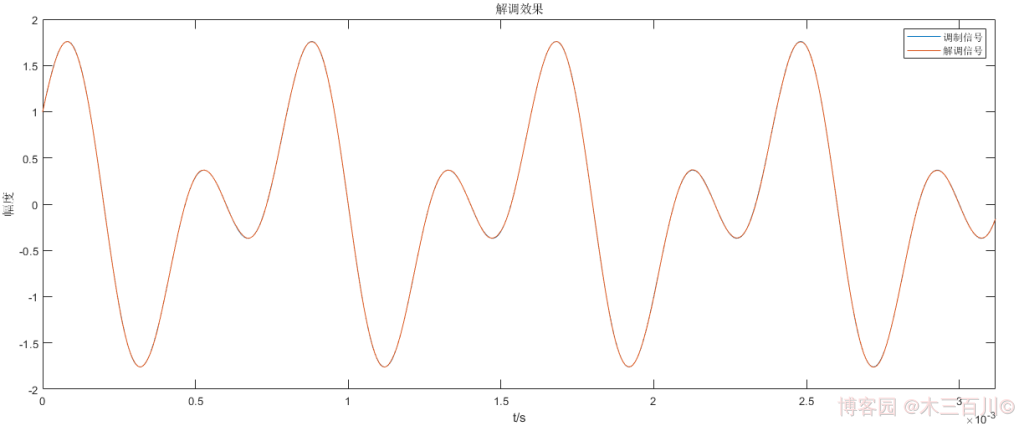
對 1.5 節中的 USB 訊號,設定訊雜比 \(SNR=50dB\),解調效果如下,計算誤差,有:\(\sqrt{\sum{{\lvert}m(t_i)-\hat{m}(t_i){\rvert}^2}}/\sqrt{\sum{{\lvert}m(t_i){\rvert}^2}}\approx0.0022\),與 LSB 相同。

程式碼詳見 demod_ssb_method3.m 和 main_demodSSB_example3.m。與相干解調(同步檢測)一樣,這種方法對相干載波同頻同相的要求較高。
2.4 希爾伯特變換解調
根據 Hilbert 變換的性質,在 \(f_c \gg f_{max}\) 的條件下(\(f_c\) 為訊號的載波頻率,\(f_{max}\) 為調變訊號的最大頻率分量),有以下近似的表示式(USB 訊號時為 「\(+\)」,LSB 訊號時為 「\(-\)」):
可據此設計出以下解調方法:
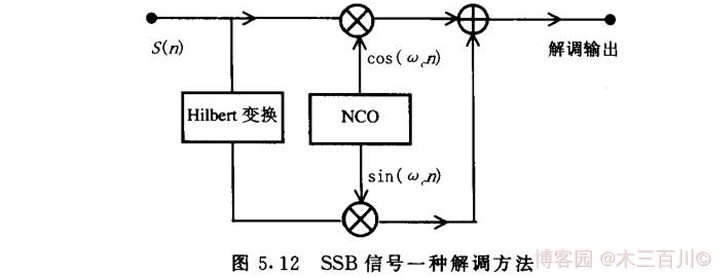
聯立式 \((9)\) 和式 \((13)\) 可得解調輸出為:
這一方法的解調步驟如下(注意:這一解調方法需滿足的條件是 \(f_c \gg f_{max}\)):
- 第一步:計算訊號 \(s_{SSB}(t)\) 的希爾伯特變換 \(\hat{s}_{SSB}(t)\)。
- 第二步:\(s_{SSB}(t)\) 與 \(\hat{s}_{SSB}(t)\) 分別乘以正交載波 \(2cos(\omega_ct+{\phi_0})\) 與 \(2sin(\omega_ct+{\phi_0})\) 後相加,前面的 2 被用來做幅度補償,獲得解調輸出 \(m_o(t)=2s_{SSB}(t)cos(\omega_ct)+2\hat{s}_{SSB}(t)sin(\omega_ct)\)。
對 1.5 節中的 LSB 訊號,設定訊雜比 \(SNR=50dB\),解調效果如下,計算誤差,有:\(\sqrt{\sum{{\lvert}m(t_i)-\hat{m}(t_i){\rvert}^2}}/\sqrt{\sum{{\lvert}m(t_i){\rvert}^2}}\approx0.0032\)。
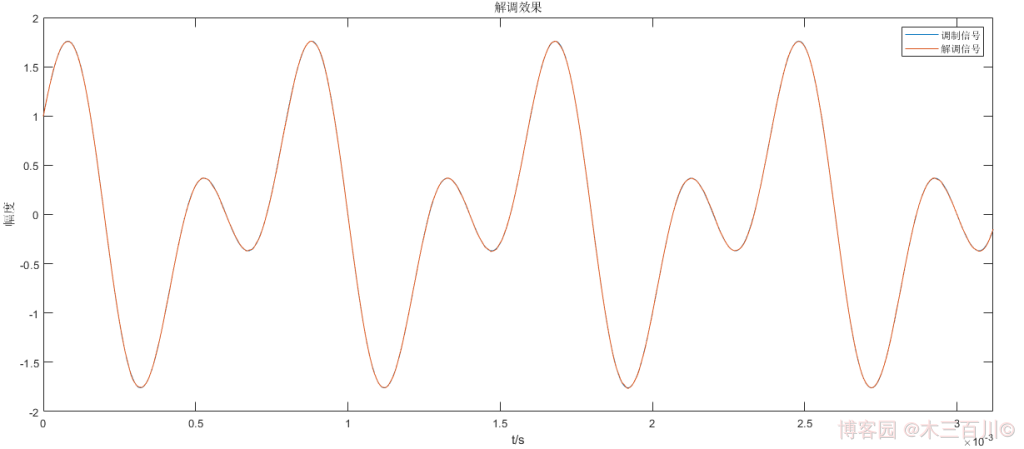
對 1.5 節中的 USB 訊號,設定訊雜比 \(SNR=50dB\),解調效果如下,計算誤差,有:\(\sqrt{\sum{{\lvert}m(t_i)-\hat{m}(t_i){\rvert}^2}}/\sqrt{\sum{{\lvert}m(t_i){\rvert}^2}}\approx0.0032\),與 LSB 相同。
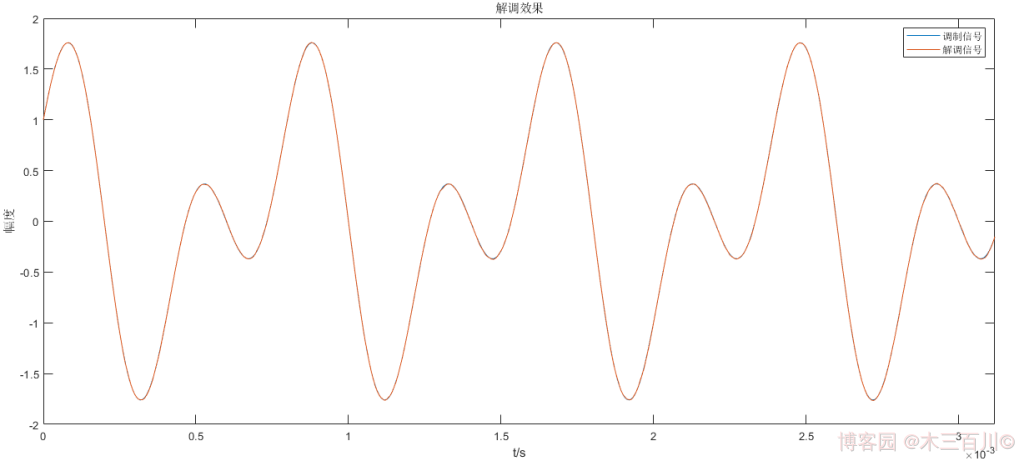
程式碼詳見 demod_ssb_method4.m 和 main_demodSSB_example4.m。更改正交載波的初始相位為 \({\phi_0}=\pi/4,\pi/2\),或者更改正交載波的中心頻率為 \(0.8f_c,1.2f_c\) 後,解調效果變差,說明這種方法對正交載波同頻同相的要求也較高。
3. SSB 模擬(MATLAB Communications Toolbox)
MATLAB 的 Communications Toolbox 中提供了 SSB 調變函數 ssbmod,高斯白噪聲函數 awgn,以及 SSB 解調函數 ssbdemod,可以很方便地完成 SSB 訊號模擬。使用這三個函數實現上面 1.4 節中確知訊號 \(m(t)\) 的 USB 調變解調,調變後加噪聲的效果如下:

USB 解調效果如下,解調訊號與調變訊號波形基本重回,計算誤差,有:\(\sqrt{\sum{{\lvert}m(t_i)-\hat{m}(t_i){\rvert}^2}}/\sqrt{\sum{{\lvert}m(t_i){\rvert}^2}}\approx0.0036\)。
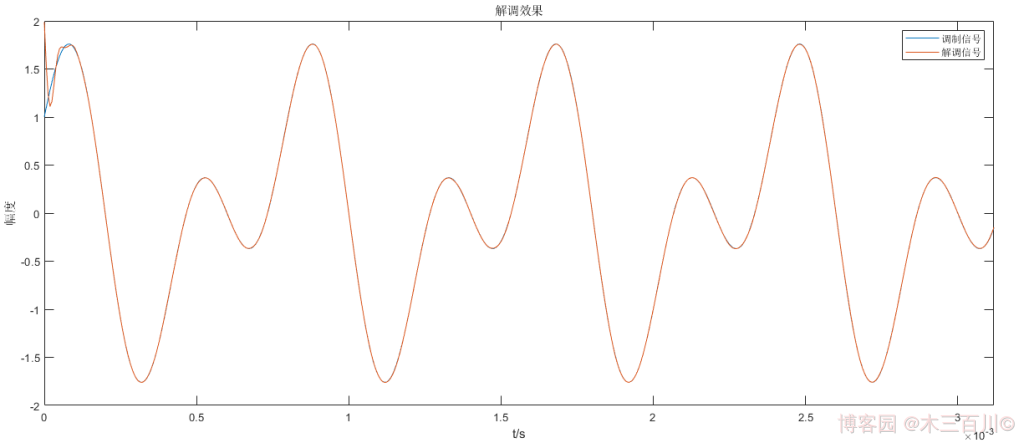
使用這三個函數實現上面 1.4 節中確知訊號 \(m(t)\) 的 LSB 調變解調,調變後加噪聲的效果如下:

LSB 解調效果如下,解調訊號與調變訊號波形基本重回,計算誤差,有:\(\sqrt{\sum{{\lvert}m(t_i)-\hat{m}(t_i){\rvert}^2}}/\sqrt{\sum{{\lvert}m(t_i){\rvert}^2}}\approx0.0036\)。
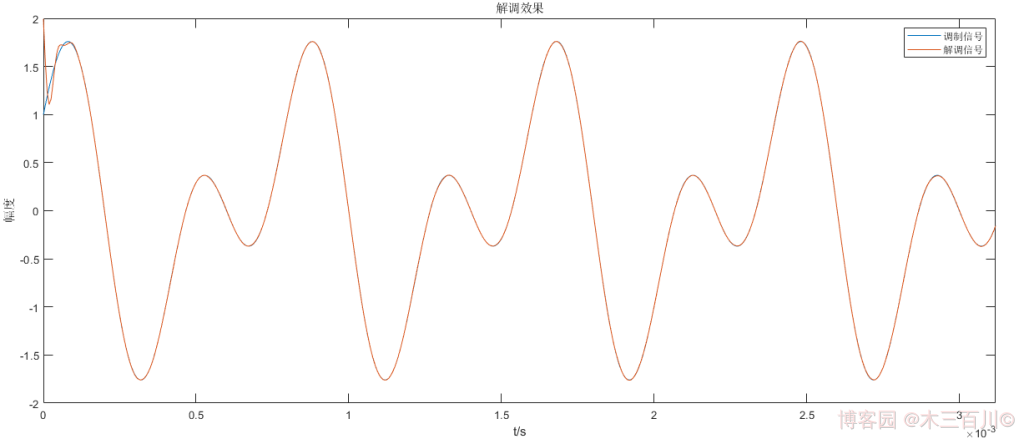
程式碼詳見附錄 main_CommSSB_example.m。
參考資料
[1] 樓才義,徐建良,楊小牛.軟體無線電原理與應用[M].電子工業出版社,2014.
[2] 樊昌信,曹麗娜.通訊原理.第7版[M].國防工業出版社,2012.
[3] CSDN - 通訊原理之模擬幅度調變(線性調變)詳解。
[4] 簡書 - 第五章 模擬調變系統。
[5] CSDN - 現代通訊原理6.2:單邊帶(SSB)調變。
[6] 知乎 - 希爾伯特變換如何理解?。
[7] 知乎 - matlab希爾伯特變換實現(Hilbert transfrom)。
附錄程式碼
附.1 檔案 lpf_filter.m
function sig_lpf = lpf_filter(sig_data, cutfre)
% LPF_FILTER 自定義理想低通濾波器
% 輸入引數:
% sig_data 待濾波資料
% cutfre 截止頻率,範圍 (0,1)
% 輸出引數:
% sig_lpf 低通濾波結果
% @author 木三百川
nfft = length(sig_data);
lidx = round(nfft/2-cutfre*nfft/2);
ridx = nfft - lidx;
sig_fft_lpf = fftshift(fft(sig_data));
sig_fft_lpf([1:lidx,ridx:nfft]) = 0;
sig_lpf = real(ifft(fftshift(sig_fft_lpf)));
end
附.2 檔案 hpf_filter.m
function sig_hpf = hpf_filter(sig_data, cutfre)
% HPF_FILTER 自定義理想高通濾波器
% 輸入引數:
% sig_data 待濾波資料
% cutfre 截止頻率,範圍 (0,1)
% 輸出引數:
% sig_hpf 高通濾波結果
% @author 木三百川
nfft = length(sig_data);
lidx = round(nfft/2-cutfre*nfft/2);
ridx = nfft - lidx;
sig_fft_hpf = fftshift(fft(sig_data));
sig_fft_hpf(lidx:ridx) = 0;
sig_hpf = real(ifft(fftshift(sig_fft_hpf)));
end
附.3 檔案 mod_lsb_method1.m
function [ sig_lsb ] = mod_lsb_method1(fc, fs, mt, t)
% MOD_LSB_METHOD1 LSB 下邊帶調幅(濾波法)
% 輸入引數:
% fc 載波中心頻率
% fs 訊號取樣率
% mt 調變訊號
% t 取樣時間
% 輸出引數:
% sig_lsb LSB 下邊帶調幅實訊號
% @author 木三百川
% 生成 DSB 訊號
ct = cos(2*pi*fc*t);
sig_dsb = mt.*ct; % DSB 雙邊帶調幅訊號
% 使用理想低通濾波器獲得 LSB 訊號
sig_lsb = lpf_filter(sig_dsb, fc/(fs/2));
% 繪圖
nfft = length(sig_lsb);
freq = (-nfft/2:nfft/2-1).'*(fs/nfft);
figure;set(gcf,'color','w');
plot_length = min(500, length(sig_lsb));
subplot(3,2,1);
plot(t(1:plot_length), mt(1:plot_length));xlim([t(1),t(plot_length)]);
xlabel('t/s');ylabel('幅度');title('調變訊號m(t)');
subplot(3,2,2);
plot(freq, 10*log10(fftshift(abs(fft(mt,nfft)/nfft))+eps));xlim([freq(1),freq(end)]);
xlabel('頻率/hz');ylabel('幅度/dB');title('調變訊號m(t)雙邊幅度譜');
subplot(3,2,3);
plot(t(1:plot_length), sig_dsb(1:plot_length));xlim([t(1),t(plot_length)]);
xlabel('t/s');ylabel('幅度');title('DSB雙邊帶調幅訊號s(t)');
subplot(3,2,4);
plot(freq, 10*log10(fftshift(abs(fft(sig_dsb,nfft)/nfft))+eps));xlim([freq(1),freq(end)]);
xlabel('頻率/hz');ylabel('幅度/dB');title('DSB雙邊帶調幅訊號s(t)雙邊幅度譜');
subplot(3,2,5);
plot(t(1:plot_length), sig_lsb(1:plot_length));xlim([t(1),t(plot_length)]);
xlabel('t/s');ylabel('幅度');title('LSB下邊帶調幅訊號s(t)');
subplot(3,2,6);
plot(freq, 10*log10(fftshift(abs(fft(sig_lsb,nfft)/nfft))+eps));xlim([freq(1),freq(end)]);
xlabel('頻率/hz');ylabel('幅度/dB');title('LSB下邊帶調幅訊號s(t)雙邊幅度譜');
end
附.4 檔案 mod_lsb_method2.m
function [ sig_lsb ] = mod_lsb_method2(fc, fs, mt, t)
% MOD_LSB_METHOD2 LSB 下邊帶調幅(相移法)
% 輸入引數:
% fc 載波中心頻率
% fs 訊號取樣率
% mt 調變訊號
% t 取樣時間
% 輸出引數:
% sig_lsb LSB 下邊帶調幅實訊號
% @author 木三百川
% 計算 m(t) 的希爾伯特變換(相移)
hmt = imag(hilbert(mt));
% 與正交載波相合成
sig_lsb = 1/2*mt.*cos(2*pi*fc*t)+1/2*hmt.*sin(2*pi*fc*t);
% 繪圖
nfft = length(sig_lsb);
freq = (-nfft/2:nfft/2-1).'*(fs/nfft);
figure;set(gcf,'color','w');
plot_length = min(500, length(sig_lsb));
subplot(3,2,1);
plot(t(1:plot_length), mt(1:plot_length));xlim([t(1),t(plot_length)]);
xlabel('t/s');ylabel('幅度');title('調變訊號m(t)');
subplot(3,2,2);
plot(freq, 10*log10(fftshift(abs(fft(mt,nfft)/nfft))+eps));xlim([freq(1),freq(end)]);
xlabel('頻率/hz');ylabel('幅度/dB');title('調變訊號m(t)雙邊幅度譜');
subplot(3,2,3);
plot(t(1:plot_length), hmt(1:plot_length));xlim([t(1),t(plot_length)]);
xlabel('t/s');ylabel('幅度');title('調變訊號m(t)希爾伯特變換');
subplot(3,2,4);
plot(freq, 10*log10(fftshift(abs(fft(hmt,nfft)/nfft))+eps));xlim([freq(1),freq(end)]);
xlabel('頻率/hz');ylabel('幅度/dB');title('調變訊號m(t)希爾伯特變換雙邊幅度譜');
subplot(3,2,5);
plot(t(1:plot_length), sig_lsb(1:plot_length));xlim([t(1),t(plot_length)]);
xlabel('t/s');ylabel('幅度');title('LSB下邊帶調幅訊號s(t)');
subplot(3,2,6);
plot(freq, 10*log10(fftshift(abs(fft(sig_lsb,nfft)/nfft))+eps));xlim([freq(1),freq(end)]);
xlabel('頻率/hz');ylabel('幅度/dB');title('LSB下邊帶調幅訊號s(t)雙邊幅度譜');
end
附.5 檔案 mod_usb_method1.m
function [ sig_usb ] = mod_usb_method1(fc, fs, mt, t)
% MOD_USB_METHOD1 USB 上邊帶調幅(濾波法)
% 輸入引數:
% fc 載波中心頻率
% fs 訊號取樣率
% mt 調變訊號
% t 取樣時間
% 輸出引數:
% sig_usb USB 上邊帶調幅實訊號
% @author 木三百川
% 生成 DSB 訊號
ct = cos(2*pi*fc*t);
sig_dsb = mt.*ct; % DSB 雙邊帶調幅訊號
% 使用理想高通濾波器獲得 USB 訊號
sig_usb = hpf_filter(sig_dsb, fc/(fs/2));
% 繪圖
nfft = length(sig_usb);
freq = (-nfft/2:nfft/2-1).'*(fs/nfft);
figure;set(gcf,'color','w');
plot_length = min(500, length(sig_usb));
subplot(3,2,1);
plot(t(1:plot_length), mt(1:plot_length));xlim([t(1),t(plot_length)]);
xlabel('t/s');ylabel('幅度');title('調變訊號m(t)');
subplot(3,2,2);
plot(freq, 10*log10(fftshift(abs(fft(mt,nfft)/nfft))+eps));xlim([freq(1),freq(end)]);
xlabel('頻率/hz');ylabel('幅度/dB');title('調變訊號m(t)雙邊幅度譜');
subplot(3,2,3);
plot(t(1:plot_length), sig_dsb(1:plot_length));xlim([t(1),t(plot_length)]);
xlabel('t/s');ylabel('幅度');title('DSB雙邊帶調幅訊號s(t)');
subplot(3,2,4);
plot(freq, 10*log10(fftshift(abs(fft(sig_dsb,nfft)/nfft))+eps));xlim([freq(1),freq(end)]);
xlabel('頻率/hz');ylabel('幅度/dB');title('DSB雙邊帶調幅訊號s(t)雙邊幅度譜');
subplot(3,2,5);
plot(t(1:plot_length), sig_usb(1:plot_length));xlim([t(1),t(plot_length)]);
xlabel('t/s');ylabel('幅度');title('USB上邊帶調幅訊號s(t)');
subplot(3,2,6);
plot(freq, 10*log10(fftshift(abs(fft(sig_usb,nfft)/nfft))+eps));xlim([freq(1),freq(end)]);
xlabel('頻率/hz');ylabel('幅度/dB');title('USB上邊帶調幅訊號s(t)雙邊幅度譜');
end
附.6 檔案 mod_usb_method2.m
function [ sig_usb ] = mod_usb_method2(fc, fs, mt, t)
% MOD_USB_METHOD2 USB 上邊帶調幅(相移法)
% 輸入引數:
% fc 載波中心頻率
% fs 訊號取樣率
% mt 調變訊號
% t 取樣時間
% 輸出引數:
% sig_usb USB 上邊帶調幅實訊號
% @author 木三百川
% 計算 m(t) 的希爾伯特變換(相移)
hmt = imag(hilbert(mt));
% 與正交載波相合成
sig_usb = 1/2*mt.*cos(2*pi*fc*t)-1/2*hmt.*sin(2*pi*fc*t);
% 繪圖
nfft = length(sig_usb);
freq = (-nfft/2:nfft/2-1).'*(fs/nfft);
figure;set(gcf,'color','w');
plot_length = min(500, length(sig_usb));
subplot(3,2,1);
plot(t(1:plot_length), mt(1:plot_length));xlim([t(1),t(plot_length)]);
xlabel('t/s');ylabel('幅度');title('調變訊號m(t)');
subplot(3,2,2);
plot(freq, 10*log10(fftshift(abs(fft(mt,nfft)/nfft))+eps));xlim([freq(1),freq(end)]);
xlabel('頻率/hz');ylabel('幅度/dB');title('調變訊號m(t)雙邊幅度譜');
subplot(3,2,3);
plot(t(1:plot_length), hmt(1:plot_length));xlim([t(1),t(plot_length)]);
xlabel('t/s');ylabel('幅度');title('調變訊號m(t)希爾伯特變換');
subplot(3,2,4);
plot(freq, 10*log10(fftshift(abs(fft(hmt,nfft)/nfft))+eps));xlim([freq(1),freq(end)]);
xlabel('頻率/hz');ylabel('幅度/dB');title('調變訊號m(t)希爾伯特變換雙邊幅度譜');
subplot(3,2,5);
plot(t(1:plot_length), sig_usb(1:plot_length));xlim([t(1),t(plot_length)]);
xlabel('t/s');ylabel('幅度');title('USB上邊帶調幅訊號s(t)');
subplot(3,2,6);
plot(freq, 10*log10(fftshift(abs(fft(sig_usb,nfft)/nfft))+eps));xlim([freq(1),freq(end)]);
xlabel('頻率/hz');ylabel('幅度/dB');title('USB上邊帶調幅訊號s(t)雙邊幅度譜');
end
附.7 檔案 main_modSSB_example1.m
clc;
clear;
close all;
% SSB 調變模擬(調變訊號為確知訊號,濾波法)
% @author 木三百川
% 調變引數
fm = 2500; % 調變訊號引數
fc = 20000; % 載波頻率
fs = 8*fc; % 取樣率
total_time = 2; % 模擬時長,單位:秒
% 取樣時間
t = 0:1/fs:total_time-1/fs;
% 調變訊號為確知訊號
mt = sin(2*pi*fm*t)+cos(pi*fm*t);
% LSB 調變
[ sig_lsb ] = mod_lsb_method1(fc, fs, mt, t);
% USB 調變
[ sig_usb ] = mod_usb_method1(fc, fs, mt, t);
附.8 檔案 main_modSSB_example2.m
clc;
clear;
close all;
% SSB 調變模擬(調變訊號為確知訊號,相移法)
% @author 木三百川
% 調變引數
fm = 2500; % 調變訊號引數
fc = 20000; % 載波頻率
fs = 8*fc; % 取樣率
total_time = 2; % 模擬時長,單位:秒
% 取樣時間
t = 0:1/fs:total_time-1/fs;
% 調變訊號為確知訊號
mt = sin(2*pi*fm*t)+cos(pi*fm*t);
% LSB 調變
[ sig_lsb ] = mod_lsb_method2(fc, fs, mt, t);
% USB 調變
[ sig_usb ] = mod_usb_method2(fc, fs, mt, t);
附.9 檔案 demod_ssb_method1.m
function [ sig_ssb_demod ] = demod_ssb_method1(sig_ssb_receive, fc, fs, t, phi0)
% DEMOD_SSB_METHOD1 SSB 插入載波包絡檢波法
% 輸入引數:
% sig_ssb_receive SSB 接收訊號,行向量
% fc 載波中心頻率
% fs 訊號取樣率
% t 取樣時間
% phi0 載波初始相位
% 輸出引數:
% sig_ssb_demod 解調結果,與 sig_ssb_receive 等長
% @author 木三百川
% 第一步:插入載波
A0 = max(abs(sig_ssb_receive))/0.8;
sig_ssb2am = sig_ssb_receive + A0*cos(2*pi*fc*t+phi0);
% 第二步:使用 AM 解調器進行解調
[ sig_ssb_demod ] = demod_am_method4(sig_ssb2am, fs, t);
end
附.10 檔案 demod_ssb_method2.m
function [ sig_ssb_demod ] = demod_ssb_method2(sig_ssb_receive, fc, fs, t, phi0)
% DEMOD_SSB_METHOD2 SSB 相干解調(同步檢測)
% 輸入引數:
% sig_ssb_receive SSB 接收訊號,行向量
% fc 載波中心頻率
% fs 訊號取樣率
% t 取樣時間
% phi0 載波初始相位
% 輸出引數:
% sig_ssb_demod 解調結果,與 sig_ssb_receive 等長
% @author 木三百川
% 第一步:乘以相干載波
sig_ssbct = 4*sig_ssb_receive.*cos(2*pi*fc*t+phi0);
% 第二步:低通濾波
sig_ssb_demod = lpf_filter(sig_ssbct, fc/(fs/2));
end
附.11 檔案 demod_ssb_method3.m
function [ sig_ssb_demod ] = demod_ssb_method3(sig_ssb_receive, fc, fs, t, phi0)
% DEMOD_SSB_METHOD3 SSB 數位正交解調,與相干解調(同步檢測)是等效的
% 輸入引數:
% sig_ssb_receive SSB 接收訊號,行向量
% fc 載波中心頻率
% fs 訊號取樣率
% t 取樣時間
% phi0 載波初始相位
% 輸出引數:
% sig_ssb_demod 解調結果,與 sig_ssb_receive 等長
% @author 木三百川
% 第一步:乘以正交相干載波
sig_ssb_i = 4*sig_ssb_receive.*cos(2*pi*fc*t+phi0);
sig_ssb_q = -4*sig_ssb_receive.*sin(2*pi*fc*t+phi0);
% 第二步:低通濾波
sig_ssb_i_lpf = lpf_filter(sig_ssb_i, fc/(fs/2));
sig_ssb_q_lpf = lpf_filter(sig_ssb_q, fc/(fs/2));
sig_ssb_demod = sig_ssb_i_lpf;
end
附.12 檔案 demod_ssb_method4.m
function [ sig_ssb_demod ] = demod_ssb_method4(sig_ssb_receive, fc, t, phi0)
% DEMOD_SSB_METHOD4 SSB 希爾伯特變換解調
% 輸入引數:
% sig_ssb_receive SSB 接收訊號,行向量
% fc 載波中心頻率
% t 取樣時間
% phi0 載波初始相位
% 輸出引數:
% sig_ssb_demod 解調結果,與 sig_ssb_receive 等長
% @author 木三百川
% 第一步:計算希爾伯特變換
hsig_ssb_receive = imag(hilbert(sig_ssb_receive));
% 第二步:乘以正交相干載波
sig_ssb_demod = 2*sig_ssb_receive.*cos(2*pi*fc*t+phi0)+2*hsig_ssb_receive.*sin(2*pi*fc*t+phi0);
end
附.13 檔案 main_demodSSB_example1.m
clc;
clear;
close all;
% SSB 解調模擬(調變訊號為確知訊號,插入載波包絡檢波法)
% @author 木三百川
% 調變引數
fm = 2500; % 調變訊號引數
fc = 20000; % 載波頻率
fs = 8*fc; % 取樣率
total_time = 2; % 模擬時長,單位:秒
% 取樣時間
t = 0:1/fs:total_time-1/fs;
% 調變訊號為確知訊號
mt = sin(2*pi*fm*t)+cos(pi*fm*t);
% SSB 調變
[ sig_ssb_send ] = mod_usb_method2(fc, fs, mt, t);
% 加噪聲
snr = 50; % 訊雜比
sig_ssb_receive = awgn(sig_ssb_send, snr, 'measured');
% 插入載波包絡檢波法
phi0 = 0;
[ sig_ssb_demod ] = demod_ssb_method1(sig_ssb_receive, fc, fs, t, phi0);
% 繪圖
nfft = length(sig_ssb_receive);
freq = (-nfft/2:nfft/2-1).'*(fs/nfft);
figure;set(gcf,'color','w');
plot_length = min(500, length(sig_ssb_receive));
subplot(1,2,1);
plot(t(1:plot_length), sig_ssb_receive(1:plot_length));xlim([t(1),t(plot_length)]);
xlabel('t/s');ylabel('幅度');title('SSB接收訊號');
subplot(1,2,2);
plot(freq, 10*log10(fftshift(abs(fft(sig_ssb_receive,nfft)/nfft))+eps));xlim([freq(1),freq(end)]);
xlabel('頻率/hz');ylabel('幅度/dB');title('SSB接收訊號雙邊幅度譜');
figure;set(gcf,'color','w');
plot(t(1:plot_length), mt(1:plot_length));xlim([t(1),t(plot_length)]);
hold on;
plot(t(1:plot_length), sig_ssb_demod(1:plot_length));xlim([t(1),t(plot_length)]);
xlabel('t/s');ylabel('幅度');title('解調效果');
legend('調變訊號','解調訊號');
coef = mean(abs(mt))/mean(abs(sig_ssb_demod));
fprintf('norm(調變訊號 - %.2f * 解調訊號)/norm(調變訊號) = %.4f.\n', coef, norm(mt-coef*sig_ssb_demod)/norm(mt));
附.14 檔案 main_demodSSB_example2.m
clc;
clear;
close all;
% SSB 解調模擬(調變訊號為確知訊號,相干解調(同步檢測))
% @author 木三百川
% 調變引數
fm = 2500; % 調變訊號引數
fc = 20000; % 載波頻率
fs = 8*fc; % 取樣率
total_time = 2; % 模擬時長,單位:秒
% 取樣時間
t = 0:1/fs:total_time-1/fs;
% 調變訊號為確知訊號
mt = sin(2*pi*fm*t)+cos(pi*fm*t);
% SSB 調變
[ sig_ssb_send ] = mod_usb_method2(fc, fs, mt, t);
% 加噪聲
snr = 50; % 訊雜比
sig_ssb_receive = awgn(sig_ssb_send, snr, 'measured');
% 相干解調(同步檢測)
phi0 = 0;
[ sig_ssb_demod ] = demod_ssb_method2(sig_ssb_receive, fc, fs, t, phi0);
% 繪圖
nfft = length(sig_ssb_receive);
freq = (-nfft/2:nfft/2-1).'*(fs/nfft);
figure;set(gcf,'color','w');
plot_length = min(500, length(sig_ssb_receive));
subplot(1,2,1);
plot(t(1:plot_length), sig_ssb_receive(1:plot_length));xlim([t(1),t(plot_length)]);
xlabel('t/s');ylabel('幅度');title('SSB接收訊號');
subplot(1,2,2);
plot(freq, 10*log10(fftshift(abs(fft(sig_ssb_receive,nfft)/nfft))+eps));xlim([freq(1),freq(end)]);
xlabel('頻率/hz');ylabel('幅度/dB');title('SSB接收訊號雙邊幅度譜');
figure;set(gcf,'color','w');
plot(t(1:plot_length), mt(1:plot_length));xlim([t(1),t(plot_length)]);
hold on;
plot(t(1:plot_length), sig_ssb_demod(1:plot_length));xlim([t(1),t(plot_length)]);
xlabel('t/s');ylabel('幅度');title('解調效果');
legend('調變訊號','解調訊號');
coef = mean(abs(mt))/mean(abs(sig_ssb_demod));
fprintf('norm(調變訊號 - %.2f * 解調訊號)/norm(調變訊號) = %.4f.\n', coef, norm(mt-coef*sig_ssb_demod)/norm(mt));
附.15 檔案 main_demodSSB_example3.m
clc;
clear;
close all;
% SSB 解調模擬(調變訊號為確知訊號,數位正交解調)
% @author 木三百川
% 調變引數
fm = 2500; % 調變訊號引數
fc = 20000; % 載波頻率
fs = 8*fc; % 取樣率
total_time = 2; % 模擬時長,單位:秒
% 取樣時間
t = 0:1/fs:total_time-1/fs;
% 調變訊號為確知訊號
mt = sin(2*pi*fm*t)+cos(pi*fm*t);
% SSB 調變
[ sig_ssb_send ] = mod_usb_method2(fc, fs, mt, t);
% 加噪聲
snr = 50; % 訊雜比
sig_ssb_receive = awgn(sig_ssb_send, snr, 'measured');
% 數位正交解調
phi0 = 0;
[ sig_ssb_demod ] = demod_ssb_method3(sig_ssb_receive, fc, fs, t, phi0);
% 繪圖
nfft = length(sig_ssb_receive);
freq = (-nfft/2:nfft/2-1).'*(fs/nfft);
figure;set(gcf,'color','w');
plot_length = min(500, length(sig_ssb_receive));
subplot(1,2,1);
plot(t(1:plot_length), sig_ssb_receive(1:plot_length));xlim([t(1),t(plot_length)]);
xlabel('t/s');ylabel('幅度');title('SSB接收訊號');
subplot(1,2,2);
plot(freq, 10*log10(fftshift(abs(fft(sig_ssb_receive,nfft)/nfft))+eps));xlim([freq(1),freq(end)]);
xlabel('頻率/hz');ylabel('幅度/dB');title('SSB接收訊號雙邊幅度譜');
figure;set(gcf,'color','w');
plot(t(1:plot_length), mt(1:plot_length));xlim([t(1),t(plot_length)]);
hold on;
plot(t(1:plot_length), sig_ssb_demod(1:plot_length));xlim([t(1),t(plot_length)]);
xlabel('t/s');ylabel('幅度');title('解調效果');
legend('調變訊號','解調訊號');
coef = mean(abs(mt))/mean(abs(sig_ssb_demod));
fprintf('norm(調變訊號 - %.2f * 解調訊號)/norm(調變訊號) = %.4f.\n', coef, norm(mt-coef*sig_ssb_demod)/norm(mt));
附.16 檔案 main_demodSSB_example4.m
clc;
clear;
close all;
% SSB 解調模擬(調變訊號為確知訊號,希爾伯特變換解調)
% @author 木三百川
% 調變引數
fm = 2500; % 調變訊號引數
fc = 20000; % 載波頻率
fs = 8*fc; % 取樣率
total_time = 2; % 模擬時長,單位:秒
% 取樣時間
t = 0:1/fs:total_time-1/fs;
% 調變訊號為確知訊號
mt = sin(2*pi*fm*t)+cos(pi*fm*t);
% SSB 調變
[ sig_ssb_send ] = mod_usb_method2(fc, fs, mt, t);
% 加噪聲
snr = 50; % 訊雜比
sig_ssb_receive = awgn(sig_ssb_send, snr, 'measured');
% 希爾伯特變換解調
phi0 = 0;
[ sig_ssb_demod ] = demod_ssb_method4(sig_ssb_receive, fc, t, phi0);
% 繪圖
nfft = length(sig_ssb_receive);
freq = (-nfft/2:nfft/2-1).'*(fs/nfft);
figure;set(gcf,'color','w');
plot_length = min(500, length(sig_ssb_receive));
subplot(1,2,1);
plot(t(1:plot_length), sig_ssb_receive(1:plot_length));xlim([t(1),t(plot_length)]);
xlabel('t/s');ylabel('幅度');title('SSB接收訊號');
subplot(1,2,2);
plot(freq, 10*log10(fftshift(abs(fft(sig_ssb_receive,nfft)/nfft))+eps));xlim([freq(1),freq(end)]);
xlabel('頻率/hz');ylabel('幅度/dB');title('SSB接收訊號雙邊幅度譜');
figure;set(gcf,'color','w');
plot(t(1:plot_length), mt(1:plot_length));xlim([t(1),t(plot_length)]);
hold on;
plot(t(1:plot_length), sig_ssb_demod(1:plot_length));xlim([t(1),t(plot_length)]);
xlabel('t/s');ylabel('幅度');title('解調效果');
legend('調變訊號','解調訊號');
coef = mean(abs(mt))/mean(abs(sig_ssb_demod));
fprintf('norm(調變訊號 - %.2f * 解調訊號)/norm(調變訊號) = %.4f.\n', coef, norm(mt-coef*sig_ssb_demod)/norm(mt));
附.17 檔案 main_CommSSB_example.m
clc;
clear;
close all;
% SSB 調變解調模擬(使用Communications Toolbox工具箱)
% @author 木三百川
% 調變引數
fm = 2500; % 調變訊號引數
fc = 20000; % 載波頻率
fs = 8*fc; % 取樣率
total_time = 2; % 模擬時長,單位:秒
% 取樣時間
t = 0:1/fs:total_time-1/fs;
% 調變訊號為確知訊號
mt = sin(2*pi*fm*t)+cos(pi*fm*t);
% SSB 調變
ini_phase = 0;
sig_ssb_send = ssbmod(mt,fc,fs,ini_phase); % LSB 調變
% sig_ssb_send = ssbmod(mt,fc,fs,ini_phase,'upper'); % USB 調變
% 加噪聲
snr = 50; % 訊雜比
sig_ssb_receive = awgn(sig_ssb_send, snr, 'measured');
% SSB 解調
[ sig_ssb_demod ] = ssbdemod(sig_ssb_receive, fc, fs, ini_phase);
% 繪圖
nfft = length(sig_ssb_receive);
freq = (-nfft/2:nfft/2-1).'*(fs/nfft);
figure;set(gcf,'color','w');
plot_length = min(500, length(sig_ssb_receive));
subplot(1,2,1);
plot(t(1:plot_length), sig_ssb_receive(1:plot_length));xlim([t(1),t(plot_length)]);
xlabel('t/s');ylabel('幅度');title('SSB接收訊號');
subplot(1,2,2);
plot(freq, 10*log10(fftshift(abs(fft(sig_ssb_receive,nfft)/nfft))+eps));xlim([freq(1),freq(end)]);
xlabel('頻率/hz');ylabel('幅度/dB');title('SSB接收訊號雙邊幅度譜');
figure;set(gcf,'color','w');
plot(t(1:plot_length), mt(1:plot_length));xlim([t(1),t(plot_length)]);
hold on;
plot(t(1:plot_length), sig_ssb_demod(1:plot_length));xlim([t(1),t(plot_length)]);
xlabel('t/s');ylabel('幅度');title('解調效果');
legend('調變訊號','解調訊號');
coef = mean(abs(mt))/mean(abs(sig_ssb_demod));
fprintf('norm(調變訊號 - %.2f * 解調訊號)/norm(調變訊號) = %.4f.\n', coef, norm(mt-coef*sig_ssb_demod)/norm(mt));
本文作者:木三百川
本文連結:https://www.cnblogs.com/young520/p/17546613.html
版權宣告:本文系博主原創文章,著作權歸作者所有。商業轉載請聯絡作者獲得授權,非商業轉載請附上出處連結。遵循 署名-非商業性使用-相同方式共用 4.0 國際版 (CC BY-NC-SA 4.0) 版權協定。